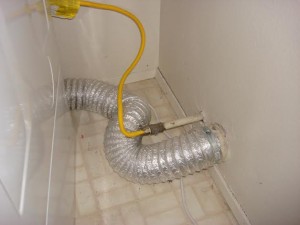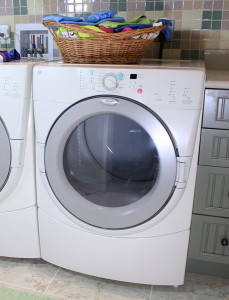Many homeowners don’t realize just how potentially dangerous it is to do laundry. According to the National Fire Protection Association, between 2010 to 2014, there were an estimated 15,970 fires due to washers and dryers in the United States each year. Interestingly, the innocent-looking clothes dryer accounted for 92% of those fires.
These fires resulted in 13 civilian deaths, 440 civilian injuries and $238 million in property damage.
With over 20 years of experience as only one of two women Certified Dryer Exhaust Technicians in California, I know the importance of safety as it relates to dryer vents. Here are important safety-related “Do’s” and “Don’ts” to reduce the chance of dryer fires
Nine Important “Do’s” for Dryer Vents
1) When installing a new dryer, always install a new connector hose between the dryer and the wall. This hose should be a metal connector hose, either rigid or  flexible. If your connector hose is white plastic or vinyl, replace it immediately since those are potential fire hazards. In the case of a flexible hose, the hose should only be long enough to go between the dryer and the wall with a little slack so that if you pull out the dryer, the hose still stays connected to the wall. The Chimney Safety Institute of America (CSIA) recommends that this connector hose never be longer than eight feet. For tight spaces behind the dryer, here is a link for options for dryer vent hoses.
flexible. If your connector hose is white plastic or vinyl, replace it immediately since those are potential fire hazards. In the case of a flexible hose, the hose should only be long enough to go between the dryer and the wall with a little slack so that if you pull out the dryer, the hose still stays connected to the wall. The Chimney Safety Institute of America (CSIA) recommends that this connector hose never be longer than eight feet. For tight spaces behind the dryer, here is a link for options for dryer vent hoses.
2) Always clean out the lint screen before each load. Never use your dryer without the lint screen installed.
3) Using dryer sheets or dryer pads may leave a chemical film on your lint screen, which makes your dryer harder to “breathe.” If you use these products, clean your lint screen using water, liquid soap and a toothbrush every few months.
4) Keep combustible and volatile materials away from your dryer. Paper products like toilet paper and paper towels should not be stored too close to the dryer. In addition, flammable or volatile chemicals such as alcohol, gasoline, motor oil, finishing oils and stains, spot removers, solvents, cleaning agents and cooking oils should not be stored in the laundry room. These chemicals are not only flammable but they can also give off toxic vapors and odors.
5) Always check pockets before you do your laundry. Paper products such as receipts, note paper, or cocktail napkins will get past the lint screen and land inside the dryer under the drum where the paper becomes a fire hazard. Dryer sheets or dryer pads can also get into the vent. Sometimes this paper, along with lint which you have no control over, will get passed from the dryer into the dryer vent where it mixes with moisture from drying your clothes and becomes paper mache inside the vent pipe. This will clog up the vent, creating a potential fire hazard for your dryer.
6) Just because the dryer venting system is clean, doesn’t mean you never have to worry about dryer fires. The lint and paper accumulation inside the dryer under the drum is the fuel that creates the dryer fires. Contact an appliance repair company to periodically have the lint and paper accumulation cleaned out from the body of the dryer, under the drum.
7) Due to the high incidence of dryer fires, an ABC-type fire extinguisher located close to the dryer is highly recommended in a visible and accessible location.
8) In addition to the fire hazard associated with dryer fires, there’s also the issue of carbon monoxide poisoning. Blocked or plugged up dryer vents for gas dryers may allow carbon monoxide to back up into the home. It is highly recommended to install a carbon monoxide detector close to the dryer when you have a gas dryer.
9) Have the dryer vents professionally brushed out on a regular basis. Professionals vary as to the frequency for cleaning out the dryer vents but the CSIA recommends that the dryer vent be checked on an annual basis. Of course, your laundry habits as well as how the dryer venting system is routed will be contributing factors in the frequency of the dryer vent cleaning. To find a qualified Certified Dryer Exhaust Technician in your area, go to www.csia.org. Make sure that the technician uses a brushing method to scrub the vent clean.
Many companies will only use vacuums or air pressure which will simply remove the loose accumulation from the dryer vent which is a waste of your time and money. A professional Dryer Exhaust Technician will also use a Magnehelic Gage or Vane Anemometer to measure the air flow of the dryer vent system after the dryer vent cleaning.
Nine Important “Don’ts” for Dryer Vents
1) Don’t push the dryer too close to the wall behind the clothes dryer. The connector hose should not be kinked or crushed which will reduce air flow. Not only will this create more lint in the dryer but your dryer will run hotter than it needs to, setting you up for a dangerous dryer fire.
2) Don’t close the door to the laundry room or laundry closet when your dryer is on. According to the Uniform Mechanical Code, a dryer needs 100 square inches of “make-up air,” the equivalent of a 10″x10″ window. Without this make-up air, the dryer will run harder and hotter than it needs to. This isn’t good for the dryer and it’s not safe for you.
3) Don’t use the exhaust fan in your laundry room if the dryer is on. The exhaust fan pulls air out of the room, which makes your dryer harder to bring in the make-up air that it needs.
4) Never dry clothes that have flammable or volatile chemicals on them. Instead, dry these clothes outside.
5) Don’t overload your dryer. It makes your dryer run harder and hotter than it needs to. This will create extra wear-and-tear on your dryer as well as expensive dryer repairs, and it will reduce the lifespan of your dryer.
6) Your dryer brings in make-up air from underneath and in front of your dryer. Don’t block this area with baskets of laundry. There should be a minimum of 18″ of open area in front of your dryer.
7) Never dry rubber-backed rugs or bathroom mats or other items with foam, plastic or vinyl materials. Not only does this potentially create a fire hazard, but it’ll ruin the items due to the high heat.
8) Dryers must always vent to the exterior of the house and never into enclosed areas like garages, attics, or crawl spaces. Never use the indoor dryer vent box kits purchased from the big box stores. These are not to code and can be especially dangerous if you’re venting a gas dryer.
9) Lastly and most importantly, NEVER run your dryer if you’re not at home or if you’re asleep. I receive several phone calls a month from people whose dryer caught on fire. You want to be home AND awake in case it does.
Following these tips will reduce the chance of dangerous dryer fires and will keep you worry-free while doing your laundry!



These are some great tips here! Found your site based on damper blockers after an SDG&E safety check (great info there by the way, and a total easy fix) and continued reading. My favorite tip here was leaving my laundry closet open when running the dryer so it gets the air flow it needs. We’re in a new place and I was wondering why it was taking so long to do a dry cycle. After reading this tip, and leaving the door on the small laundry closet open when using the dryer, I can totally notice the difference. The darn thing wasn’t getting enough air flow and working harder than it needed to.
Since we now leave the laundry closet door open the dryer gets the job done in about 20-30 mins! And, we are saving money on gas/electric and have lessened our fire risk.
We love your blog tips and knowledge relating to fireplaces and dryers. Keep up the great work with the education! Especially from a local San Diego business! You guys rock.
Hello,
My condo complex has the dryer vent tied into the bathroom vents and this causes lint and moisture to come out in the bathrooms. This seems like a pretty serious safety hazard due to the dryer being gas powered and mold issues. Do you know if this is against any safety codes? I’m about to break the dryer off that line and run it’s own line if possible.
Thank You!
Jeremiah,
You are absolutely right to be concerned. Most building codes, if not all, require that the dryer be vented to the exterior and should not be tied into any other venting system. Since I don’t know what part of the U.S. you’re in, I don’t know which building code you fall under.
As you very astutely pointed out, in the case where you have a gas dryer, it exhausts carbon monoxide, in which case these gases can infiltrate into the bathroom.
Your other concern about this being a potential for mold is a valid concern. For every load of laundry you dry, you’re venting out a half of gallon of condensation which can create mold.
I would highly recommend that you contact a local company to bid on re-routing the dryer vent system. In most areas of the country, code requires that the length of the run be no more than 25′ and for every 90 degree bend, you reduce that by 5′. The vent MUST BE 4″ in diameter (NOT 3″ in diameter) and should be galvanized metal. At the joints, the male end of the duct must face away from the dryer or in the direction of the airflow. Do not let the contractor use the flexible connector hose in any enclosed area. The connector hose is only to be used for the short distance between the dryer and the wall and is not intended nor designed for the entire venting system.
If your system is routed this way, the likelihood is that the rest of the condos in your development have the same routing for their dryer vent system. This may be something that the HOA should address as a whole.
Good luck to you!
Terri Pocock, Owner
Swede Chimney Sweep & Dryer Vent Cleaning
Thanks for the reminder that overloading can also be a problem when using a dryer. I will keep that in mind after getting dryer vent services soon. I might need to get mine repaired after overusing it recently.
I’m a renter and use a basement dryer that seems to have never had the venting cleaned. I’m concerned because it’s a fire hazard and it’s right below our apartment! The landlord won’t do it so Im trying to DIY 20 feet of duct. Is it possible to disconnect the venting and wash it? I don’t have the scrubbing tool, and there’s an inch of compacted lint inside, even at the exit point.
Hi. Do you recommend the dryer be lined up to the vent. Currently the dryer is to the side. We have the washer in front of the vent because of where the washer connectors. I’m wondering if I should switch them?